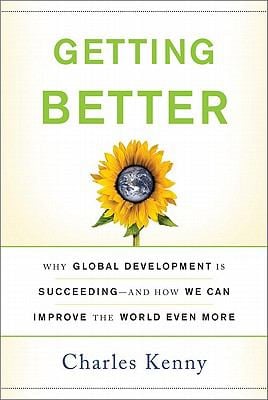I just started reading Getting Better: Why Global Development Is Succeeding--And How We Can Improve the World Even More by my friend Charles Kenny. He points out that the estimated incomes for English working class 600 years ago is roughly similar to that of the Indian poor today. He also points out the difficulty of comparing Gross Domestic Product (GDP) estimates across time and across countries. Finally, he stresses that technology improvement has improved the quality of life for the poor in developing countries in ways that don't show up in income estimates. It occurred to me to post on some of the differences between a typical rural family in England six centuries ago and one in India today.
Health: Actually neither would see a doctor often if at all. For the English family, that would be all to the good because seeing a doctor 600 years ago would have been more likely to harm than help the patient. The Indian family will not worry about smallpox nor plague since they have been banished from modern medicine, while the English 600 years ago would have had a right to be very concerned. In the past diphtheria, whooping cough, tetanus, measles and mumps were serious problems causing a lot of sickness and death, but are largely absent today since they are prevented by routine immunization. Protection could not have been purchased by our English family and would be free to our Indian. Malaria was common in much of the south and south-west of England 600 years ago, but has been controlled in India. The result of the changes in technology mean that the Indian children will be much more likely to survive to become adults, the adults to live longer, and all at little or no cost to the family.
Family Planning: Condoms, birth control pills, IUDs, vasectomy and tubal ligation have all been invented in the last century. The medieval English family would have had few options but having large numbers of children, many of whom would not survive. The Indian family has many options, and with the knowledge that most of their children will survive, will have fewer children. Contraception will probably be inexpensive, probably subsidized for the poor.
Schooling: Most English poor children would not have gone to school six centuries ago. Most Indian children will benefit from primary school since schools are available, their costs subsidized, and since families have incentives to educate their children and fewer children to educate.
Food: In the last 600 years many food crops once confined to single areas have spread across the world, and improved varieties have been developed and widely disseminated by modern research. The Green Revolution was especially successful in India, combining improved varieties, irrigation and chemicals. The English farmer six centuries ago was living on the edge of famine, while agricultural productivity has increased significantly in India. The Indian farm family today not only feeds itself, but provides a surplus to help feed the increasing urban population. Still, much of its production may never enter the market, being consumed in the local community.
 |
| A farmer inspecting a field on the outskirts of Bhubaneswar, Orissa. |
Housing: The poor in medieval England and modern India both would live in very modest housing. The Indian would benefit as compared with the Brit from a relatively mild climate.
Transportation: The rural poor in medieval England would have walked. They would not have spent money on transportation, but would not have had access to services or markets at any distance. Rural India may not be well supplied with means of transportation by the standards of rich countries, but would have immeasurably better access than his medieval British counterpart. As a result the Indian would have many more cost effective alternatives seek services and buy and sell goods using the modern system of transportation.
Information: Radio is ubiquitous in India today, mobile telephones are reaching the villages, and television too. Indeed, in many areas of India there are Internet facilities available at the village level.
Lighting: While an estimated 400 million Indians still don't have electrical power, some 800 million do. Electric light lengthens the day, and of course electrical power provides convenient inexpensive power for many other purposes. Lighting a midieval rural home was difficult and expensive, not much done.
The end result of the massive technological change over the centuries is that rural Indian families today are in many ways better off than their medieval English counterparts, even if the improvements do not show up in their estimated monetary income.


No comments:
Post a Comment